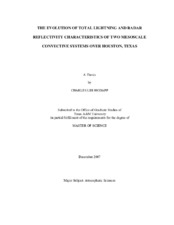| dc.description.abstract | Two mesoscale convective systems (MCSs) passed over the Houston Lightning Detection and Ranging (LDAR) network on 31 October 2005 and 21 April 2006. As the MCSs traverse the LDAR network, the systems slowly mature with a weakening convective line and a developing stratiform region and radar bright band. The intensification of stratiform region precipitation, including the bright band, is thought to play an important role in stratiform lightning structure, charge structure, and total lightning production of MCSs. The stratiform areas quadruple in size and the mean reflectivity values increase substantially by ~ 6 dB. As the stratiform region matures, VHF source density plots show a lightning pathway that slopes rearward and downward from the back of the convective line and into the stratiform region. At early times for both MCSs, the pathway extends horizontally rearward 40 to 50 km into the stratiform region at an altitude of 9 to 12 km. Near the end of the analysis time period, the pathway slopes rearward 40 km and downward through the transition zone before extending 40 to 50 km in the stratiform region at an altitude of 4 - 7 km. The sloping pathway likely results from charged ice particles advected from the convective line by storm relative front-to-rear flow while the level pathway extending further into the stratiform region is likely caused by both charge advection and local in-situ charging. As the stratiform region matures, the stratiform flash rates double and lightning heights decrease. The percentage of lightning flashes originating in the stratiform region increases significantly from 10 - 20% to 50 - 60%. Overall, the number of positive cloud-to-ground flashes in the stratiform region also increases. Between both MCSs, 60% of the positive CGs originated in the convective or transition regions. Both in-situ charging mechanisms created by the development of the mesoscale updraft and charge advection by the front-to-rear flow likely contribute to the increased electrification and lightning in the stratiform region. | en |


